
The Karnak Temple Complex, commonly known as Karnak, comprises a vast mix of decayed temples, pylons, chapels, and other buildings near Luxor, Egypt. Construction at the complex began during the reign of Senusret I in the Middle Kingdom and continued into the Ptolemaic Kingdom, although most of the extant buildings date from the New Kingdom. The area around Karnak was the ancient Egyptian Ipet-isut and the main place of worship of the 18th Dynastic Theban Triad, with the god Amun as its head. It is part of the monumental city of Thebes, and in 1979 it was added to the UNESCO World Heritage List along with the rest of the city. The Karnak complex gives its name to the nearby, and partly surrounded, modern village of El-Karnak, 2.5 kilometres north of Luxor.

A pylon is a monumental gate of an Egyptian temple. The word comes from the Greek term πυλών 'gate'. It consists of two pyramidal towers, each tapered and surmounted by a cornice, joined by a less elevated section enclosing the entrance between them. The gate was generally about half the height of the towers. Contemporary paintings of pylons show them with long poles flying banners.
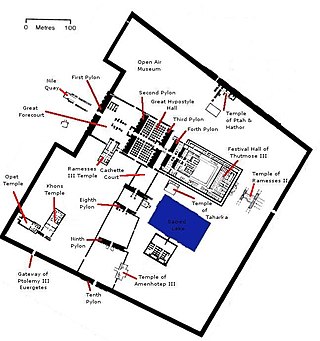
The Precinct of Amun-Re, located near Luxor, Egypt, is one of the four main temple enclosures that make up the immense Karnak Temple Complex. The precinct is by far the largest of these and the only one that is open to the general public. The temple complex is dedicated to the principal god of the Theban Triad, Amun, in the form of Amun-Re.

The Temple of Ptah is a shrine located within the large Precinct of Amun-Re at Karnak, in Luxor, Egypt. It lies to the north of the main Amun temple, just within the boundary wall. The building was erected by the Pharaoh Thutmose III on the site of an earlier Middle Kingdom temple. The edifice was later enlarged by the Ptolemaic Kingdom.

The Lummus Park Historic District or simply Lummus Park, is on the National Register of Historic Places and a locally historic designated district in Miami, Florida. It is roughly bound by Northwest Fifth Street to the north, Flagler Street to the south, Northwest Third Avenue to the east, and the Miami River to the west. On October 25, 2006, it was added to the U.S. National Register of Historic Places. Lummus Park has some of the oldest structures in Miami, and over the decades, has been able to retain a large part of its early pioneer character.

The Salt Lake Masonic Temple is the Masonic headquarters for Utah, and is Salt Lake City's best example of Egyptian Revival architecture. It was completed in 1927, and is located in the South Temple Historic District of Salt Lake City, Utah, United States.

The Scottish Rite Cathedral in Indianapolis, Indiana is a historic building designed by architect George F. Schreiber and located in downtown Indianapolis. It is owned by the Valley of Indianapolis Scottish Rite, an affiliated body of Freemasonry. It was built between 1927 and 1929 at the cost of $2.5 million. The Cathedral is one of the largest Masonic buildings in the world and the largest Scottish Rite building anywhere. It has been described as one of the finest examples of Neo-Gothic architecture in the United States.

Government Street Presbyterian Church in Mobile, Alabama is one of the oldest and least-altered Greek Revival church buildings in the United States. The architectural design is by James Gallier Sr., James H. Dakin, and Charles Dakin. The trio also designed Barton Academy, four blocks down Government Street to the west. Government Street Presbyterian reflects the influences of Ithiel Town, Minard Lafever, and Andrew Jackson Downing. It was declared a National Historic Landmark in 1992.
Scottish Rite Cathedral and Scottish Rite Temple are names commonly applied to buildings used by Ancient and Accepted Scottish Rite, a body associated with Freemasonry. It may refer to any of a number of specific buildings, including:
The Lower Dauphin Street Historic District is a historic district in the city of Mobile, Alabama, United States. It was placed on the National Register of Historic Places on 9 February 1979. The district encompasses all of Dauphin Street from Water Street to Jefferson Street. It covers 551 acres (2.23 km2) and contains 736 contributing buildings. The boundaries were increased on 19 February 1982, 30 June 1995, and 14 August 1998. The buildings range in age from the 1820s to the 20th century and include the Federal, Greek Revival, Queen Anne, Italianate, and various other Victorian architectural styles.
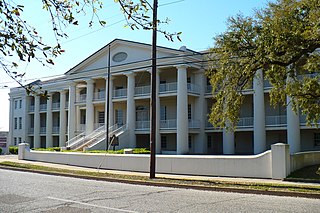
Mobile City Hospital, also known as Old Mobile General Hospital, is a historic Greek Revival hospital building in Mobile, Alabama, United States. It was built in 1830 by Thomas S. James and served as a hospital for the city of Mobile from 1831 until 1966. It was administered for the city by the Sisters of Charity throughout a large part of its history. Residents of the city were treated here during epidemics of yellow fever and during the American Civil War. It was converted to office space after 1966. It was added to the National Register of Historic Places on February 26, 1970. The building is adjacent to the old U.S. Marine Hospital, which is also on the National Register.

Ad-Dakka was a place in Lower Nubia. It is the site of the Greco-Roman Temple of Dakka, dedicated to Thoth, the god of wisdom in the ancient Egyptian pantheon. The temple was initially a small one-room shrine or chapel, first begun in the 3rd century BC by a Meroitic king named Arqamani in collaboration with Ptolemy IV who added an antechamber and a gate structure. Ptolemy IX "subsequently enlarged the temple by adding a pronaos with two rows of probably three columns." During the Roman period, the Emperors Augustus and Tiberius further enlarged the structure with "the addition, at the rear, of a second sanctuary as well as inner and outer enclosure walls with a large pylon. The sanctuary contained a granite naos." The Temple of Dakka was transformed into a temple fortress by the Romans and surrounded by a stone wall, 270 by 444 metres long, with an entrance along the Nile.
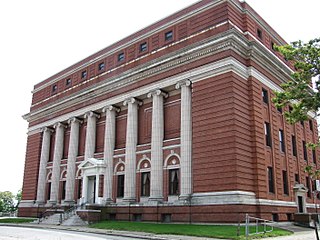
The Worcester Masonic Temple is a historic Masonic temple Located at 1 Ionic Avenue in downtown Worcester, Massachusetts. Construction on the temple began on September 12, 1913, with the laying of the cornerstone. The building was finished and dedicated on September 3, 1914, by the then Grand Master, Most Worshipful Melvin M. Johnson.

The Quincy Masonic Temple was a historic Masonic temple at 1170 Hancock Street, Quincy, Massachusetts. It was built in 1926 and added to the National Register of Historic Places in 1989. The building was home to three "Blue" Masonic Lodges, two Appendant Bodies: York Rite, Grotto, and two Youth Groups: DeMolay and Rainbow.

The First Church of Christ and the Ancient Burying Ground is a historic church and cemetery at 60 Gold Street in Hartford, Connecticut. It is the oldest church congregation in Hartford, founded in 1636 by Thomas Hooker. The present building, the congregation's fourth, was built in 1807, and was listed on the National Register of Historic Places in 1972. The adjacent cemetery, formally set apart in 1640, was the city's sole cemetery until 1803.

George Bigelow Rogers (1870–1945) was an American architect, best known for the wide variety of buildings that he designed in Mobile, Alabama, including mansions in historic European styles and other private residences, churches and public buildings, and the first 11-story skyscraper in Mobile and the Southeast United States. Many of his structures have been listed on the National Register of Historic Places.
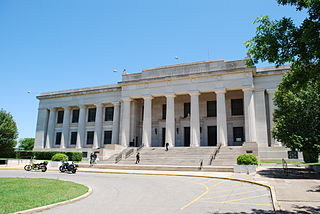
The Scottish Rite Temple in Guthrie, Oklahoma, is a Masonic temple that serves as the home of the Scottish Rite in the Guthrie Valley, Oklahoma Orient, Ancient and Accepted Scottish Rite of Freemasonry, Southern Jurisdiction, U.S.A. This is actually a complex consisting of two buildings on a 10 acres (40,000 m2) plot of ground on Oklahoma Avenue in downtown Guthrie that was originally named Capitol Park.

The Mosque of the El Jebel Shrine, which has also been known as the Rocky Mountain Consistory, and as the Scottish Rite Temple is a historic building in the North Capitol Hill neighborhood of downtown Denver. It was for a period known as Sherman Street Event Center
The Scottish Rite Cathedral in Meridian, Mississippi is a former building that was listed on the United States National Register of Historic Places. The building was designed in Egyptian Revival style by prolific Meridian architect P.J. Krouse, who also designed Meridian City Hall in 1915 and the 1906 Greek Revival building used by Congregation Beth Israel.
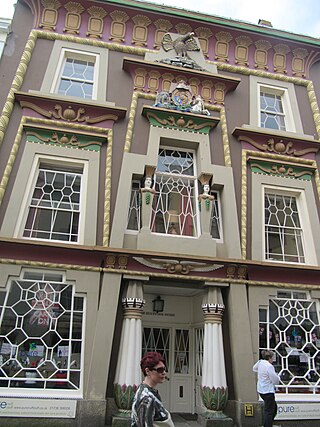
Egyptian Revival architecture in the British Isles is a survey of motifs derived from Ancient Egyptian sources occurring as an architectural style. Egyptian Revival architecture is comparatively rare in the British Isles. Obelisks start appearing in the 17th century, mainly as decorative features on buildings and by the 18th century they started to be used in some numbers as funerary or commemorative monuments. In the later 18th century, mausoleums started to be built based on pyramids, and sphinxes were used as decorative features associated with monuments or mounted on gate piers. The pylon, a doorway feature with spreading jambs which support a lintel, also started to be used and became popular with architects.





















